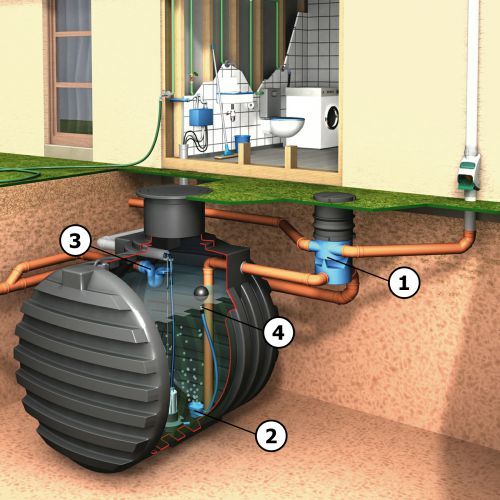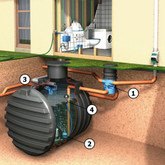Rainwater Harvesting for use in the home, in agriculture, office and other commercial environments is becoming more popular. Storing rainwater for later use can reduce water and sewage bills and allow you to water a garden during a hosepipe ban with gentler rainwater rather than treated tap water. Using rainwater in a washing machine or in agricultural sprayers can also reduce the use of chemical conditioners .
When you collect water from your roof it is important to ensure that it is filtered before it is stored in water tanks so that it is as clean as possible and doesn't go sour or smelly before you use it.
In a professional Rainwater Harvesting System, whether the water is stored in an above ground tank or one buried in the ground, there are four main components you need if you want to use the rainwater in non-potable situations like; flushing toilets, washing machines, washing vehicles, watering the garden, irrigating or spraying crops etc. You will need to take extra steps (that we will detail in a later post) if you want to further filter the rainwater for drinking.

Whether you incorporate all four steps into you system is up to you. They are always recommended for below ground systems, however for smaller garden situations where you are using the water quite regularly you may only need the first step - a good downpipe filter. If you are pumping the water you should always include fourth step too - the floating intake and for all other situations the all four steps are best - especially for when you are harvesting water from roofs over 200m2!
If your Rainwater Harvesting System (for non-potable use) has all four cleaning steps then you will not run into water quality problems like brown water, smelly anaerobic water or sludge blocking pipes or water pumps.
The four step cleaning process, detailed below, uses natural processes and the natural behaviour of the water in the tank to ensure that you always use the cleanest rainwater. If you follow all four steps you will never need to add any chemicals to your water storage tank, clean out the sludge at the bottom of the tank or use a "first flush" system and lose the first lot of rain that falls and you certainly won't shouldn't get any nasty brown water stains in your toilet cisterns.
Step 1 - Filter the water before it enters the storage tank.
This is the most important step and should be taken on every rainwater harvesting system no matter what the size - whether storing the water in a waterbutt for use in the garden, above ground rainwater tanks for large commercial systems or in below ground water tanks.
Always fit the best Filter that you can afford and one that is sized for the roof area that you are collecting water from (or has a built in overflow if your roof area is larger than the water storage capacity you need).
A good Filter will remove the larger debris falling like leaves, feathers and other detritus and ensure that those items are able to continue down your downpipe guttering (as they would have before you installed your rainwater harvesting system) and not clog it up or, in larger systems, be diverted to Waste.
A Filter with a stainless steel mesh is best and, ideally, at this stage you should be looking to filter the water to at least 1mm (1000 micron) - the finer the better.
The Rainwater Filter should be installed where it is easy to inspect for maintenance and should be easy to clean. All filters need cleaning from time to time depending on proximity of your roof in relation to trees etc.
The pre-cleaned rainwater, with some small debris like pollen and oils then flows into your water storage tank.
Step 2 - Oxygenate the water.
Keeping the rainwater oxygenated while it is in the water tank stops it from going anaerobic (smelly). The question is, how do you make the water move without disturbing the residual particles (that are heavier than water) that have settled to the bottom of the water tank? The answer is quite ingenious in it's simplicity. You make sure the water flowing into your tank goes through a Calmed Inlet a the bottom of your water tank.
A calmed inlet is a simple device that ensures that the water coming into the tank jets upwards from the bottom of the tank and oxygenates the water above the sediment without actually disturbing the settled debris. The natural movement of the water above the Calmed Inlet when it rains is enough to keep the water oxygenated.
When you are collecting rainwater from roofs larger than about 100m2 or into tanks larger than 2000 litres installing a
Calmed Inlet is recommended.
Step 3 - Siphon off any floating particles.
Any particles that are finer than your filter mesh and lighter than water, like pollen and oils, will float to the top of your stored water.
The best way to get rid of the floating debris is to skim it off. An Overflow Siphon is by far the easiest way to do this. It is installed at the high water level in your tank and has a short horizontal slot in it's design so that the light particles fall into it when the water reaches that height. It is self-cleaning as it acts as an overflow too - any excess rainwater will flow out of the tank at this point too and back down your downpipe or to Waste.
Overflow Siphons are recommended on rainwater harvesting systems where you are collecting water from roofs larger than about 100m2 or into tanks larger than 2000 litres.
Step 4 - Fit a moving fine mesh filter before the pump.
If you are pumping the rainwater for use in the garden, home, office or other commercial situation. The fourth and final step is essential to ensure that you only put the cleanest water through your water pump.
A "moving fine mesh filter" is convoluted way of saying a "Floating Intake". Floating Intakes (unlike static mesh filters that are built into some pumps) enable the filter mesh to move within the cleanest part of the stored water.
Remember, particles smaller than your filter (fitted in Step 1) will either float to the top of your stored water or sink to the bottom of your water tank. Therefore the cleanest water will be in the middle. Floating Intakes are fine mesh filters fitted to some hose - the length of which can be defined to fit your storage tank. A the mesh filter dangles from a float, so it is always kept below the very top of the water.
The movement of the mesh fine filter is important. Water is sucked into the pump, so any small debris that hasn't settled into it's final position is in danger or being caught against the mesh. If the mesh stayed in one position all the time, the debris would eventually clog up the fine mesh, however because a Floating Intake is allowed to move within water any debris that may have been sucked against the mesh will be pushed off it as the float sways back and forth (from the currents created by the flow of rainwater into the tank).
Rainwater Harvesting System Kits
We have put together a number of rainwater harvesting system kits:
- In-tank Rainwater Pump Kits,
- Rainwater Filter Kits for Below Ground Tanks,
- Rainwater Filter Kits for Above Ground Water Tanks,
- Below Ground Rainwater Tanks.
Rainwater Harvesting Water Quality Questions
We will in time write a troubleshooting guide to some of the more frequent questions we get asked about water quality in Rainwater Harvesting Systems.
In the meantime, however, if you are in the UK and have any problems with your current system or would simply like some advice about installing a Rainwater Harvesting System on a new build or retrofitting to an existing building, please do contact us.

